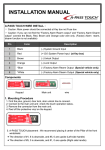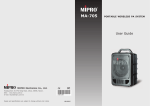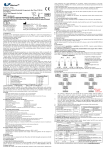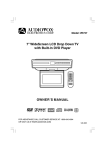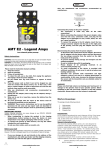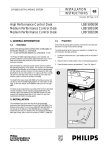Download SM30 system datasheet - Bosch public address systems
Transcript
10/30/01 11:16 AM Page 111 MICROPROCESSOR CONTROLLED • USER FRIENDLY ALLOWING SPECIFIC FUNCTIONS TO BE EASILY AND SPEEDILY PROGRAMMED • SYSTEM EXPANSION MADE EASY AND ECONOMICAL DUE TO A LARGE RANGE OF PLUG-IN MODULES • 48 VOLT EMERGENCY BATTERY POWER SUPPLY CONNECTOR • SM30 SOUND M A N AG E M E N T S YS T E M PA databook.qxd EEPROM USER’S DATA STORAGE • The SM30 Sound Management System is a highly sophisticated professional public address facility controller, incorporating all the necessary interface circuitry for the comprehensive range input and output modules. The system has been designed to meet commonly requested public address facilities. A Call Station, including a high quality cardioid electret condenser microphone, keypad buttons, and function keys, allows the operator to route and transmit calls, announcements, music, and alarm signals. A system of priorities has been drawn up to cope with conflict situations when a call is requested from two Call Stations simultaneously. Up to 36 loudspeaker zones can be selected all together, with several zones combined, or individually by typing in the zone number. The SM30 system is intended for use with 2 separate channels. One channel will amplify the “call” signal, and the other one the “music” signal.This allows the music to be transmitted without interruption, when a call is made to other loudspeaker zones.To fulfil the need of amplified power, more amplifiers can be installed. LBB 1280 range SM30 SOUND MANAGEMENT SYSTEM Since the SM30 system is controlled by a microprocessor, it is particularly flexible and the specific functions can easily be programmed or changed by non-technical personnel.All signal switching and routing procedures are carried out by the software, so that wiring problems are kept to a minimum. In order to meet the various application needs, a range of plug-in modules are available. The modules slide in and out quickly, making the SM30 system simple and inexpensive to assemble, to install, and to maintain. The SM30 system has a pilot tone signal which can be used for the surveillance of power amplifiers and their output devices. A signal tone generator produces more than 40 chime, attention, and alarm signals.These signals can be programmed to precede a call or pre-recorded message, or to be activated independently if required. The SM30 system can be programmed by using the programming keys and the LCD Display on the front panel. The programming menus are presented in the selected language. Normally the Power Supply Module is connected to the mains, but a 48 V DC emergency battery supply connector is available. A ‘Delayed Power On’ function is available to save battery power by switching on amplifiers of the SQ45 range, only when a Call is made. Since the user’s data is stored in an EEPROM, a battery back-up facility is unnecessary. System Operation A public address sound distribution system comprises a Control Centre, Call Stations and power amplifiers. The amplifiers feed the loudspeakers located in geographical Philips Communication, Security & Imaging 111 PA databook.qxd 10/30/01 11:16 AM Page 112 SPECIFICATIONS LBB 1280 range SM30 SOUND MANAGEMENT SYSTEM and/or functional zones where people must be reached with background music, announcements, pre-recorded messages, and alarm signals.The SM30 system is designed to handle calls and music simultaneously by using a twochannel amplifier system. When a call is made to a particular zone or combination of zones, music playing in remaining zones will not be interrupted. A system of priorities has been developed to cope with conflict situations. For example, when a person attempts to make a call when another call is being made by someone with a higher priority, the new call will not be switched through. The SM30 system can be fed by input signals from call stations, microphones, music sources and a built-in pre-recorded messages card.The routing of an input signal is started by pushing a Numeric Keypad key or Function Key on a Call Station, closing a built-in microphone switch, or closing a contact of a remote detector device. A maximum configuration of the SM30 system contains up to 6 Call Stations and a maximum of 18 loudspeaker zones, or 3 call stations and up to 36 loudspeaker zones to be selected individually. The Call Station is the primary input to the SM30 system.When a call is activated, the following actions are carried out. The desired zones are selected by pushing the Numeric Keypad keys. The microprocessor detects which keys are pressed and, if another call is being handled at that moment, it checks the priority of the new call. If the new call has a lower priority, it will be ignored. If the new call has a higher priority, the original caller will be overridden.After this, the microprocessor checks which chime tone and/or pre-recorded message has been programmed to precede the call. Music is muted in the selected loudspeaker zones, the programmed announcement tone or message will be transmitted, the microphone is switched on and the call is transmitted. Pre-programmed control relay contacts can activate override relays in the loudspeaker enclosures to secure full volume level during transmitting. At the end of the call, the PRESS-TO-TALK key is released and the music will return at its original volume-level. 4 Function Keys are provided on the Call Station to route a call to a pre- programmed selection of zones.The call can be programmed with functions such as priority, attention signal, message, zone combination and control relay operation. Alternative functions may be given to a Function Key, such as music source select, volume up, down and mute, control relay switching or toggling and music routing. Microphone calls can be programmed with the same functions as a Call Station. However, the routing to a zone combination has to be preprogrammed. Control Input ‘calls’ can also be programmed with the available functions, depending on the specific input number. With the Direct Routing function, the control inputs can directly activate the zone relay modules of the pre-programmed music or alarm zones. For instance, an external fire detection contact connected to the control input, activates the corresponding alarm zone. If the fire expands to more buildings, the alarm zone in question will be switched in automatically. The SM30 system provides the user with more than 40 pre-programmed signals. All these signals are available to be programmed in various routing configurations. Music SQ45 Call Pilot Tone Line Output Module AUX 1 AUX 2 AUX 3 Display/ keyboard Music Input Module Zone Relay Module 1 Chime Attention Alarm Signals - Recorded Message Module 1 2 Call Station Input Module 1 Zone 1 Zone 6 Zone Relay Module 2 Zone 7 Zone 12 MICROPROCESSOR BOARD Zone Relay Module 3 Zone 13 Zone 18 1 Call Station Input 2 Module 2 Control Relay Module 1 1 Microphone Input 2 Module Mains 1 8 Control Input Module 1 Power Supply Unit 48V DC SM30 BASIC SYSTEM 1 8 1 8 1 8 Control Input Module Control Input Module Control Input Module 4 5 6 Zone 19 Zone Relay Module 4 Zone 24 Zone 25 Zone Relay Module 5 Zone 30 Zone 31 Zone Relay Module 6 Zone 36 Mains Control Relay Module 2 Chime signals The 1,2,3 or 4-tone chimes are available in two versions. In the first version, a chime tone stops when the activating key is released.The second version allows the chime to finish its cycle, even if the activating key is released. Power Supply Unit 48V DC SM30 MODULE FRAME 112 Attention signals Available signals are: fast whoop, two tone, crash signal, fire attention, etc.An attention tone stops when the activating key is released or at the end of the signal. Alarm signals All but two alarm signals are available in two versions: signal duration 60 seconds and continuous. Alarm signals are continuously transmitted, even though the activating key is released. However, an alarm signal can be terminated at any time by the operator by pressing the activating key again. In order to conform with certain European military requirements, an alarm signal can be interrupted by a call with a higher priority.After releasing the call key, the alarm signal will return for the programmed duration. Examples of available alarm signals are: DIN alarm, Muster alarm, 1 kHz tone, Morse “F”, Fast or slow whoop, specific military alarm signals. PA databook.qxd 10/30/01 11:16 AM Page 113 SPECIFICATIONS LBB 1280 range SM30 SOUND MANAGEMENT SYSTEM Basic Control Centre LBB 1280/40 The Basic Control Centre and Module Frame houses the various printed circuit boards and plug-in modules. Both units contain an Interconnection Board with 12 slots in which the plug-in modules can be fitted. The Basic Control Centre is delivered with the Line Output Module and the and Power Supply Unit. All the other modules have to be supplemented in the control centre or module frame in their own pre-designated locations.The connections between the modules and the corresponding ‘input’ and ‘output’ equipment can be made by using standard plugs and screw connector blocks. Cabinet The Control Centre and module frame are delivered with 19-inch brackets, and without cover ready for mounting in to a 19” rack. For table-top applications a cover can be ordered under type No. LBB 1349/30. A set of blanking plates can be ordered under type No. LBB 1292/00 to blank-off any empty slots. Power supply module The power supply module has a standard mains supply plug plus an emergency battery supply connector. In cases in which the mains supply is unreliable, and the SM30 system is used for security, alarm and/or evacuation purposes, an emergency battery power supply of 48 V DC can be used.This supply can be switched in automatically whenever the mains power fails. Interconnection board All of the interconnections between the plug-in modules take place automatically when they are installed. Each module has its own place in the cabinets. Misuse in other slots will cause no damage to any part of the system. The Basic Control Centre LBB 1280/40 comprises: • Cabinet • Display and Keyboard • Microprocessor Board • Interconnection Board • Power Supply Module • Line Output Module • User’s Manual The optional modules are: - Microphone Input Module - Call Station Input Module - Control Input Module - Recorded Message Module - Music Input Module - Zone Relay Module - Control Relay Module LBB 1282/00 LBB 1283/00 LBB 1284/00 LBB 1285/00 LBB 1286/10 LBB 1287/00 - LBB 1287/10 LBB 1288/00 The optional accessories are: - Call Station (18 zones) - Call Station (36 zones) LBB 9568/30 LBB 9568/36 - - Microphones (with call switch) LBB 9517/10 LBB 9520/10 LBB 9094/10 LBB 9090/00 Module frame for extended systems LBB 1291/40 Set of slot blanking plates LBB 1292/00 Top cover plate for table-top use LBB 1349/30 Line output module This module interfaces all the audio input signals and the system signal tones to the outputs. Outputs There are separate outputs for the ‘music’ and the ‘call’ channel. Output Volume Level Two separate controls allow adjustment of the output volume signal level of both the Alarm and the Chime/attention signals. Surveillance The built-in 20 kHz pilot tone signal can be used for amplifier surveillance purposes. The signal can be switched on/off and the volume level can be adjusted. Amplifier Switching Relay In a one-channel amplifier configuration, this relay can be programmed to activate the SQ45 amplifier priority relay. Display and keyboard The User Programme is a shorter version of the Installer Program. It is intended to allow the user, without the help of an expert, to alter priorities, 113 routing, etc. whenever his needs change. The programming menus are available in various languages. Programming Keys 10 Programming Keys enable the installer to programme the SM30 system to suit the system configuration and the specific needs of the user. Illuminated LEDs indicate which keys can be used at the current stage of programming. Display In the normal ‘run’ mode, the alphanumeric LCD Display indicates the name of the current music source and the volume level. In the programming mode, the display will enable the installer and user to obtain all the necessary information. PA databook.qxd 10/30/01 11:16 AM Page 114 SPECIFICATIONS LBB 1280 range SM30 SOUND MANAGEMENT SYSTEM Music Function Keys In the normal ‘run’ mode, 4 Function Keys allow the operator to select music source, to adjust the volume level up or down, and to mute the music. • Microprocessor board A microprocessor PCB controls the SM30 system. Also included is a signal generator, which is already encoded with more than 40 chime/attention tones and alarm signals.They can be programmed to precede a call, a prerecorded message, or to be activated independently. • Call Station LBB 9568/30 or Call Station LBB 9568/36 The Call Station of the SM30 system is a desktop unit which presents the operator with a logical, comprehensive, and easy to use method of routing and transmitting calls, alarms, announcements, and music. As an option, the Call Station can also be semi-flush mounted. Up to 6 Call Stations, or 3 extended call stations can be connected in the maximum configuration of the SM30 system. The wide range of features includes: Microphone Phantom powered cardioid electret condenser microphone of high quality with a built-in bass roll filter giving a clear voice reproduction, even in difficult acoustic environments. Numeric Keypad Allowing individual selection of up to 18 loudspeaker zones in a standard system, and up to 36 zones in an extended system, by typing in the zone number. Each zone has its own Zone Selection Indicator LED. A Recall Key repeats the last keypad selection. Function Keys With a Function Key a call can be routed to a pre-programmed selection of zones, saving a great amount of time when an operator has to frequently call the same zones, or when an “ALL CALL” must be made in emergencies. Each function key may be programmed for different tasks as: • routing a low priority call, preceded by an attention tone, to several frequently used loudspeaker zones. • routing an alarm tone, followed by a pre-recorded evacuation message, to all loudspeaker zones • toggling a control relay on and off which switches a warning lamp, etc. • selecting a music source, turning the music volume up/down, and muting the music. • Music routing Whenever a function key is pressed, the relevant Function Key LED and the relevant zone LEDs illuminate. Press-to-talk Key Activates a call after the zones have been preselected by means of a Keypad or Function Key. The way in which a call is executed depends on the programmed type of signal and/or message: • A normal call without attention tone or message will reset when the key is released. • A call with attention signal and/or non-repeating message will reset when the key is released. 114 A call with attention signal and repeating pre-recorded message will continue after the key is released. If you press the key for a second time, the attention signal will stop immediately and a pre-recorded message will stop at the end of the message. A call with alarm signal will continue after release of the key and can be stopped by pressing the key a second time. Busy LED LEDs are provided to advise the operator whether a call may be activated or the call is accepted.The red ‘Busy’ LED flashing means that another call is in progress. The red ‘Busy’ LED lighting up continuously indicates that the call has been blocked by another call with a higher priority. Wait/Talk LED The green ‘Wait’ LED flashing indicates that the call is accepted, and the attention tone or pre-recorded message is being transmitted. The green ‘Talk’ LED lights up continuously when the attention tone or message finishes and the microprocessor switches on the microphone to enable speech broadcast LED Intensity Preset To compensate for various local lighting conditions, the illumination intensity of the LEDs can be adjusted. Built-in Compressor Helps to keep the signal output level of the Call Station constant, even in situations where the operator’s speech volume level changes radically. The degree of compression depends on the microphone preamplifier gain setting. It can be preset over a range of 30 dB from 84 to 114 dB (SPL). Balanced Line Level Output Allows Call Stations to be located up to 1000 metres from the Control Centre. Loudspeaker Zone Template A paper template is provided, onto which the names of the loudspeaker zones can be written. LBB 9568/30 LBB 9568/36 PA databook.qxd 10/30/01 11:16 AM Page 115 SPECIFICATIONS LBB 1280 range SM30 SOUND MANAGEMENT SYSTEM Microphone Input Module LBB 1282/00 Each Microphone Input Module allows two high quality hypercardioid electret or dynamic microphones to be connected to the Control Centre. In total up to 3 Microphone Input Modules or Call Station Input Modules may be used.A microphone with priority contact must be used. Remote Switching Function The SM30 system uses the remote switching facility of microphones. The built-in switch can activate a call, including all the functions available (priority, routing, attention signals, etc.). Input Selection Selection of the Microphone Input or the Line Input (line level signal) is possible by means of a switch. Bass-Cut Facility In noisy environments, the operator often has to speak very close to the microphone which exaggerates the microphone’s bass frequencies. A basscut facility is available to reduce the bass, helping the call to be heard clearly. Selection of Bass Cut or Flat Response is possible with a switch. Gain Control As the strength of each person’s voice differs, input gain controls are used for ‘lining up’ the microphones volume level with the rest of the signal sources. Call Station Input Module LBB 1283/00 This module allows the choice of either two standard Call Stations or a single extended call station to be connected to the Control Centre. The SM30 system will accept up to 3 Call Station Input Modules and/or Microphone Input Modules in total. A standard Call Station may be connected via a cable with a length of up to 1000 metres, which contains 2 screened wires (audio signals and powering) and 2 unscreened wires (control and data signals). An extended call station can be connected using either two of the cables mentioned above. Volume Level Controls The potentiometers are input volume level controls used for “lining-up” the Call Station microphone volume level with the rest 115 of the signal sources (microphones, attention signals, background music players, etc.). The controls can be set to provide a clear, comfortable listening level for speech signals, which are balanced with the other amplified signals. Control Input Module LBB 1284/00 Each Control Input Module allows 8 remote make contacts to be connected to the Control Centre. Up to 3 Control Input Modules can be installed in the basic system, allowing a total of 24 contacts to be used. In extended systems an additional 3 Control Input Modules can be installed. When a remote contact closes, the SM30 system starts a series of preprogrammed actions. Control Inputs Each control input can be programmed similar to the functions of a call from a Call Station. In addition, direct routing control of the music or call relays on the Zone Relay Card is possible via the inputs. Control Inputs 1 to 4 Apart from the normal call activation, these inputs may be given an alternative function to allow remote activation of the Music Functions. Control Inputs 5 to 8 These inputs may be programmed to activate control relays, whose contacts can be used to start remote equipment, to activate signalling, warning lamps, etc. Control Inputs 1 to 8 These inputs can be programmed to distribute an external audio source connected to a Microphone Input Module LBB 1282. Wiring Control Inputs A plug-in, 16 terminal screw connector block is mounted for wiring the remote contacts. If the Control Centre has to be removed for some reason, the block has simply to be unplugged and the wires remain intact. This avoids the tedious and risky business of rewiring the blocks. PA databook.qxd 10/30/01 11:16 AM Page 116 SPECIFICATIONS LBB 1280 range SM30 SOUND MANAGEMENT SYSTEM Recorded Message Module LBB 1285/00 Music Input Module LBB 1286/10 A unique feature of the SM30 system is its Recorded Message Module, which allows up to 4 individual messages to be recorded and played back as desired.The SM30 system can be programmed so that a message is played back either alone, or preceding a call. The recording is digitally stored in memory chips, ensuring that the quality will not deteriorate for as long as the message is in memory. If the power of the Control Centre is switched off, a back-up battery mounted onto the module will enable the message to remain intact for up to 30 days. The maximum total recording time is 65 seconds, and up to 4 messages of varying duration may be recorded, as long as the sum of the duration’s does not exceed the maximum recording time. A bandwidth of 6 kHz ensures optimal speech intelligibility. An important feature of the SM30 system is the ability to play uninterrupted music, even though the system is handling a call routed to other loudspeaker zones.This module enables 3 independent music sources to be connected to the Control Centre. Microphone Input The 5-pole 180° DIN socket provides phantom powering, so that a high quality microphone of a condenser as well as a dynamic type may be used to record a message. Automatic Gain Control A limiter ensures that, even though the microphone signal fluctuates severely, the message is recorded at a constant level. Headphone Monitoring A socket allows the recorded messages to be monitored with a headphone, both during and after recording. Output Volume Control With a volume control potentiometer the output volume level can be “linedup” with the other signal sources. Message Recording Re-recording of messages is possible. Safety features are provided to prevent accidental erasure of the message. Remote location recording of a message is possible, as the record and monitor functions of the module are independent of the microprocessor of the SM30 system. 116 Music Source Inputs Three sets of double cinch sockets are provided to connect the music sources. The double sockets allow stereo signal sources to be connected, using standard double cinch/cinch HI-FI cables.The stereo signal is mixed to mono in the module. Input Volume Controls Three potentiometers corresponding to the inputs are provided to adjust the input volume level of each source independently. Treble and Bass Tone Controls Treble and bass potentiometers allow output control facilities. They increase the level of the relevant treble or bass frequency range by up to 10 dB and decrease the frequency range volume level by up to 10 dB. Music Control The output volume level of the Music Input Module is controlled by the 4 Music Function keys mounted on the front of the Control Centre. Remote control of these functions is possible via the Functions Keys on the Call Stations or via the Control Input Module inputs 1 to 4. Zone Relay Module LBB 1287/00,/10 The SQ45 Amplifier output signals return to the inputs of the Zone Relay Module. The relays on this module can be programmed to route the amplified call and music signals to 6 separate loudspeaker zones. Up to 3 modules can be installed in the basic Control Centre, giving the SM30 system the capacity to route calls and/or music to 18 loudspeaker zones. In PA databook.qxd 10/30/01 11:16 AM Page 117 SPECIFICATIONS LBB 1280 range SM30 SOUND MANAGEMENT SYSTEM extended systems an additional 3 modules can be installed in the module frame, to route calls and/or music to an extra 18 loudspeaker zones. Coupling Zone Relays Modules The inputs of the modules may be linked together to the outputs of the amplifier, so that one amplifier can feed up to 36 loudspeaker zones (maximum). Two versions are available. The ZRM LBB 1287/00 is made for single pole switching and the LBB 1287/10 is made for double pole switching. Multiple Amplifier Configuration In an SM30 system with a large number of loudspeakers, it may be necessary to use extra amplifiers because the high amplifier power required exceeds the power available. Each amplifier can be used to feed one Zone Relay Module which covers 6 specific zones. However, the module provides the possibility of connecting two amplifiers, so that each amplifier feeds fewer loudspeaker zones. One amplifier will feed the outputs 1 to 4 and the other will feed the outputs 5 and 6. In this case, when 3 Zone Relay Modules are installed for example, up to 6 ‘call’ and 6 ‘music’ amplifiers can be used. Termination’s The module is fitted with 2 ‘Mate-N-Lok’ connectors. All wiring is to the plugs provided with the module. Control Relay Module LBB 1288/00 The Control Relay Module contains 12 relays to be programmed separately. It provides the SM30 system with a set of make and/or break contacts for use with volume override applications, starting remote equipment, such as cassette players, message loggers, etc., to activate signalling and warning lamps, to release fire door relays, etc. Relays 1 to 8 have both make and break contacts. Relays 9 to 12 have make contacts only. In extended systems, using the SM30 Module Frame LBB 1291/40, up to two additional Control Relay Modules can be installed, providing a system with up to a maximum of 36 output contacts. If relays (25 - 36) are needed, a minor electrical and mechanical modification is required, if relays (13 - 24) are 117 needed an electrical modification only is required. Relay 1 is reserved for the indication of microprocessor errors. Relay 2 is reserved for the indication of all other internal errors in the present Modules and Call Stations. Relay 3 is dedicated to the Delayed Power ON function, but may be used for other functions. The programmable Delayed Power On function is intended for battery operated systems where, in order to save battery power, the amplifiers are switched on only when a call is made. Relay 4 is dedicated to start an external audio source, if that audio source is distributed via a Control Input Module and the audio connected to a Microphone Input Module. Relays 3 to 12 can be activated by different sources and may be used for a number of functions.Activation from a Call Station is done whenever a call is made, using the Keypad keys or the Function Keys. Relays 13 to 24 for use in extended systems using the SM30 Module Frame. Programmable features are as listed above. Relays 25 to 36 for use in extended systems using the SM30 Module Frame. Programmable features are as listed above. If used a maximum of 30 zones only is applicable. Activation can also be achieved by closing an input contact of the control input relays 5 to 8.A typical application of the Control Relay Module is the activation of the loudspeaker volume control override relays, mounted in the loudspeaker enclosures. These relays override the volume control setting of the loudspeakers to get the full volume level when a Call is transmitted. For this application, the control relays are ‘locked’ to the preprogrammed corresponding zone relays. Termination’s The module is supplied with 2 plug-in screw connector blocks with 16 terminals. The great advance of the connector block is that, if for some reason the Control Centre has to be removed, the block has simply to be unplugged and the wires remain intact. This avoids the tedious and risky business of rewiring the blocks in their original configuration. In a basic frame their is room for a single Control Relay Module. In an extended system, using an additional module frame, room is provided for an additional one or two modules. PA databook.qxd 10/30/01 11:16 AM Page 118 SPECIFICATIONS LBB 1280 range SM30 SOUND MANAGEMENT SYSTEM for power on/off switching mute by on/off switch GENERAL The specification relates to a Control Centre with corresponding modules. Pilot tone 20 kHz sinus asymmetrical volume preset at least : 0.05-1 V mute by on/off switch : > 80 dB MICROPROCESSOR HARDWARE EEPROM data storage time : >10 years RECORDED MESSAGE MODULE data retention audio bandwidth max. total recording time max. number of messages microphone phantom power supply voltage : : : : MAINS SUPPLY voltage setting at delivery mains voltage selection range maximum voltage deviation for all selected ranges however at 230 V mains mains frequency power consumption at mains voltage mains fuse mains transformer temperature switch self restoring type >30 days 320 - 6000 Hz 65 seconds 4 : 12 V DC AUDIO OUTPUTS Music input to music output gain: control range mute input level output level symmetrical: nominal maximum amplifier output distortion THD at nominal level THD at max. output amplifier S/N output at nominal level Call Station or Microphone input to call output output level symmetrical nominal maximum Microphone Input Module input level frequency response signal-to-noise ratio Call Station input level frequency response signal-to-noise ratio amplifier output distortion THD at nominal level THD at max. output : > 60 dB (2 dB steps) : > 80 dB : >150 mV : 220-230 V : 110 V, 127 V, 220-230 V or 240 V : +10/-10% : + 6/-10% : 50-60 Hz : < 90 VA : T2.5 A : +125 °C EMERGENCY SUPPLY The unit can be supplied from an external DC voltage V DC nominal : 48 V @ current: <1.2 A V DC minimum : 42 V @ current: <1.2 A V DC maximum : 58 V @ current: <1.2 A fuse in 48 V DC line on PCB located in housing polarity protection against reverse connection : 0 dBV : +12 dBV : 0.1% : 0.3% : > 80 dB (flat) MECHANICAL DATA Dimensions (H x W x D) : 0 dBV : +12 dBV : >1.5 mV : 50-15000 Hz (+/- 2 dB) : 68 dB (flat) weight LBB 1280 : 133 x 440 x 360mm ( 3HE, 19” rack height) H = 133 mm (3U) W = 440 mm (incl. 19” brackets W = 483 mm) D = 360 mm incl. handgrips. Build-in depth = 310 mm (19” rack) : 8.8 kg (unpacked) ENVIRONMENTAL REQUIREMENTS Rated range of use ambient temperature : -10 to +45 °C relative humidity : 15 - 90% : > 84 dB (SPL) : 440-12500 Hz (- 3 dB) : 58 dB (flat) : 0.1% : 0.3% Climatic conditions during transporting handling and storage according to : UN-D 1639/01 temperature : -40 to +70 °C relative humidity : 5 - 95% Music and call Output Impedance at 1 kHz : < 50 Ω Click suppression in combination for any module for audio switching : > 60 dB 9498 974 03314 01-08 : > 30 dB : > 80 dB © 2001 Philips Electronics N.V. 118








